|
|
|
Sort Order |
|
|
|
Items / Page
|
|
|
|
|
|
|
| Srl | Item |
| 1 |
ID:
136045
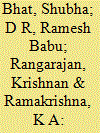

|
|
|
|
|
| Summary/Abstract |
Research on vision-based navigation of unmanned air vehicles (UAVs) has been in focus in the recent years, both in military and civilian application domains. Vision-based navigation uses features as cues to match successive images and compute the location of the UAV. The method proposed in this paper is an extension to the existing work to automatically compute scale weights of dual-tree complex wavelet transform (DTCWT) coefficients to improve the performance in terms of detection of features as against discrete wavelets or its Fourier counterparts. Existing DTCWT coefficients give improved time-shifted sensitivity, better directional selectivity with local phase information and limited redundancy. However, the drawback of this method is that the results depend on appropriate selection of scale weights α and β, which are different for different scenes. The existing technique incorporates a rule of thumb-based recommended values of α and β, irrespective of the scene which generates too many key-points, making the registration process computationally intensive. As a real-time application, the need of the problem is to extract less number of strong features. Thus, an algorithmic approach to compute optimal values of scale weights considering precision and accuracy is proposed. The method is tested on various synthetic, simulated, and aerial images having different transformations and in the presence of noise between successive images. It is observed that DTCWT descriptor performs the best and gives better results than scale invariant feature transform and Speeded up robust features.
|
|
|
|
|
|
|
|
|
|
|
|
|
|
|
|
| 2 |
ID:
151035
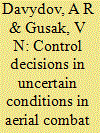

|
|
|
|
|
| Summary/Abstract |
The authors propose an approach to assess the efficiency of surface-to-air missile (SAM) forces units, taking into account the uncertainty level and the risk of making inefficient decisions on combat actions. They review a scheme to choose an alternative in the course of step-by-step decision-making. This approach is based on using information-driven decision support systems.
|
|
|
|
|
|
|
|
|
|
|
|
|
|
|
|
| 3 |
ID:
153423
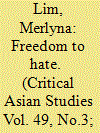

|
|
|
|
|
| Summary/Abstract |
Empirically grounded in the 2017 Jakarta Gubernatorial Election (Pilkada DKI) case, this article discusses the relationship of social media and electoral politics in Indonesia. There is no doubt that sectarianism and racism played significant roles in the election and social media, which were heavily utilized during the campaign, contributed to the increasing polarization among Indonesians. However, it is misleading to frame the contestation among ordinary citizens on social media in an oppositional binary, such as democratic versus undemocratic forces, pluralism versus sectarianism, or rational versus racist voters. Marked by the utilization of volunteers, buzzers, and micro-celebrities, the Pilkada DKI exemplifies the practice of post-truth politics in marketing the brand. While encouraging freedom of expression, social media also emboldens freedom to hate, where individuals exercise their right to voice their opinions while actively silencing others. Unraveling the complexity of the relationship between social media and electoral politics, I suggest that the mutual shaping between users and algorithms results in the formation of “algorithmic enclaves” that, in turn, produce multiple forms of tribal nationalism. Within these multiple online enclaves, social media users claim and legitimize their own versions of nationalism by excluding equality and justice for others.
|
|
|
|
|
|
|
|
|
|
|
|
|
|
|
|
| 4 |
ID:
145322
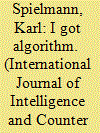

|
|
|
|
|
| Summary/Abstract |
Nate Silver is a prominent statistician/statistical probability analyst who, among other achievements, may be best known for making a very accurate prediction of President Barack Obama's victory and its dimensions in the 2012 election.1 In doing so, he probably redeemed (at least partially) the reputation of sophisticated mathematical modeling that was badly tarnished by its association with the poor investment decisions that brought the financial debacle of 2008.2 Does Silver have a potential counterpart in the intelligence business, where predicting the nature and likelihood of threats is a central concern, and what would that person have to do to rise to the occasion?
|
|
|
|
|
|
|
|
|
|
|
|
|
|
|
|
| 5 |
ID:
136043
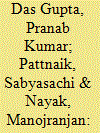

|
|
|
|
|
| Summary/Abstract |
Static images of colour clouds play an important role to predict weather conditions to schedule proof and trial activities, and deploying resources at firing locations and observation posts. In this paper, a new inter-level cloud compression architecture and algorithm has been presented. Distributed architecture suitable for cloud computing has been suggested to implement inter-level compression algorithm (ILCA). Different possibilities between two successive cloud images have been combined to save the images of interest for further processing, ignoring the redundant ones. Vector quantisation technique is briefly discussed to achieve high level of compression. The algorithm presented in this paper can be easily modified to store flying, floating, and moving objects in air, water, and surface, respectively with high level of compression in various defence applications.
|
|
|
|
|
|
|
|
|
|
|
|
|
|
|
|
| 6 |
ID:
193296
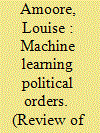

|
|
|
|
|
| Summary/Abstract |
A significant set of epistemic and political transformations are taking place as states and societies begin to understand themselves and their problems through the paradigm of deep neural network algorithms. A machine learning political order does not merely change the political technologies of governance, but is itself a reordering of politics, of what the political can be. When algorithmic systems reduce the pluridimensionality of politics to the output of a model, they simultaneously foreclose the potential for other political claims to be made and alternative political projects to be built. More than this foreclosure, a machine learning political order actively profits and learns from the fracturing of communities and the destabilising of democratic rights. The transformation from rules-based algorithms to deep learning models has paralleled the undoing of rules-based social and international orders – from the use of machine learning in the campaigns of the UK EU referendum, to the trialling of algorithmic immigration and welfare systems, and the use of deep learning in the COVID-19 pandemic – with political problems becoming reconfigured as machine learning problems. Machine learning political orders decouple their attributes, features and clusters from underlying social values, no longer tethered to notions of good governance or a good society, but searching instead for the optimal function of abstract representations of data.
|
|
|
|
|
|
|
|
|
|
|
|
|
|
|
|
| 7 |
ID:
170761


|
|
|
|
|
| Summary/Abstract |
By drawing on critical security studies in the context of a sociotechnical transition, this article calls for more attention to the presence and sometimes alternative use of mostly unobserved security practices in the materialization of everyday consumer goods and services. This call is illustrated through a discussion of the phenomenon of range anxiety and the intra-action between drivers of electric vehicles (EVs), designers, and algorithms that observe, estimate and nudge the remaining range of an EV. Inspired by Foucault and Barad, the range-anxiety discussion offers four alternative security insights. First, it supports an argument to include stress as an embodied instance of insecurity. Second, it draws attention to a security apparatus that is based on a constantly expanding assemblage around range estimates. Third, it shows how this apparatus rests on a novel algorithm that has a continuous instead of a binary output and is governed by a distributed sovereignty: where the driver simultaneously is the object of measurement, subject of governance for more efficient driving and the ultimate sovereign who decides on the trip. Lastly, the discussion highlights how range estimates not only mediate the materialization of EVs and their automobility but also (re)perform epistemological or ontological forms of uncertainty.
|
|
|
|
|
|
|
|
|
|
|
|
|
|
|
|
|
|
|
|
|